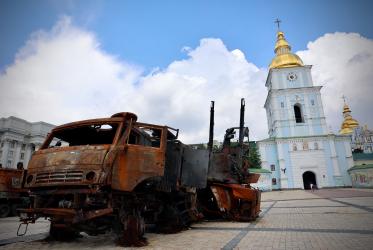Well over 250 young people came to Taizé from 30 August to 6 September 2015 to participate in the first theological symposium on “Brother Roger's Contribution to Theological Thought”. Those invited to this time of reflection and sharing were theological students and young theologians under the age of 40 engaged in research as well as those preparing for service in the church or those already involved in ministry. A wide range of speakers from all over the world aroused a great deal of interest, with contributions offered from a Protestant, Orthodox and Roman Catholic viewpoint, coming from Western and Eastern Europe as well as from Asia, North America, Latin America and Africa.
The Swiss theologian Brother Richard explained in the discussion that there was no such thing as a theology of Roger Schutz, but that there were points in his life and his life's work, in what he wrote and what he achieved, which posed questions for theology and moved it forward. For young people it was a matter of bringing their faith together with words and statements for the purpose of theological discourse. Many of their experiences of prayer or of being church, including during this week, were difficult to express in the theological concepts and categories which are expected in the university context.
All the speakers spoke about how they had been deeply influenced by personal encounters with Brother Roger, or through reading entries in his diaries, through prayer, and through attendance at Taizé gatherings in Europe and elsewhere. Dorothea Sattler, professor of dogmatics and director of the Ecumenical Institute in Münster (Germany) understood this contribution as being able to put complex theological issues into easily comprehensible words without oversimplifying the content of the message. When she was 16 years old, as a classically socialized Catholic young person, she had attended a local New Year Taizé meeting for the first time. Later during her time as a student, she pursued this ecumenical trail in Taizé itself and the impact of the experiences there have never left her.
Like other speakers, Prof Sattler pointed out that it is permissible to have doubts about faith and drew attention to details from the early biography of Brother Roger. For Roger Schutz, it was spiritual ecumenism above all that became crucial as the path to the unity of the church. Dr Sattler’s interpretation of this suggested that unity lies at the very heart of the Christian creed and Easter hope. It is a matter of being aware of the existential questions raised by human beings, the search for atonement in the face of the tangled phenomena of guilt and the expectation of the preservation of individual life even in death. Spiritual ecumenism is aligned with creation theology; i.e., it nurtures the life of all creatures and alleviates suffering. Spiritual ecumenism celebrates that which binds Christians together: one God, one faith, one baptism, one Saviour – Jesus Christ – and one Spirit, the giver of life. On the basis of Brother Roger’s early diary notes, she referred to his resistance in 1950 against the proclamation of the dogma of the bodily assumption of Mary into heaven, and above all the invoking by the Bishop of Rome of his infallible and unerring doctrinal authority as laid down by the First Vatican Council. In her view, there could be no visible unity of the Church with this papal primacy of jurisdiction and the possibility of infallible doctrinal teaching. There were, however, other concrete proposals: The Bishop of Rome could officially relinquish the exercise of his privileges, or could agree to be integrated into an ecumenical collegiate council. Might that include women, too? This was the question with which Dr Sattler closed her lecture.
The Methodist theologian and pastor Dr Hermen Shastri from Malaysia, general secretary of the Council of Churches of Malaysia, first met Roger Schutz at the Sixth Assembly of the World Coucncil of Churches in Vancouver in 1983. A member of the WCC Commission on Faith and Order, Dr Shastri put Schutz’s theology in the context of the WCC statement on “Koinonia” as a core expression of the churches‘ ecumenical search. It was not a case of seeking a visible form of church unity for today. The calling of the churches was to bring reconciliation and healing and to overcome divisions; this was the value of koinonia as the true community which includes all the gifts of all the churches. Roger Schutz might well today be pleased above all with the notion of pilgrimage and the reconciliation of individual hearts following that path, and less pleased about the path down which the ecumenical movement has gone. The pilgrim is always on a journey and is not so interested in the end of that pilgrimage.
During discussion, Dr Shastri also said that the widespread influence of Taizé on ecumenical unity and world peace is evident in churches throughout the world. Many thousands of church congregations sing Taizé songs and young people continue to be drawn to Taizé. Taizé is living ecumenism, a model for ecumenism. The ecumenical spirituality of Taizé is also a bridge in the context of Asia: here he cited the call from Taizé for peace, for change and for trust, going beyond religious and church structures outward to other religions, and this is to be a common task for human individuals and for humanity as a whole: God’s Holy Spirit may be found in all cultures, said Dr Shastri.
The unity of the churches and the unity of humankind belong together – that is ecumenism. But in Malaysia, with a 60% majority of Muslims in the population, it is difficult to attract interest in Taizé. Many churches are of an evangelical persuasion and these mega-churches are committed to a prosperity gospel which pays homage to the market economy and capitalism without any theological depth. They reckon that if they fit in with modern social and technological standards, then they can win people over; they have the answer to all the questions. He regarded the Pentecostal mega-churches as a real challenge, noting that you will find no silence there, as at Taizé. The silence found in Taizé is a source of spirituality, and it may sometimes be the case that we are not looking for answers, but for strengthening through fellowship. Dr Shastri defined silence by using the example of the interfaith memorial service for the victims of the crash of the Malaysian Airlines airplane, which brought people together across religious boundaries.
The young people who attended the colloquium made their own contribution, offering around fifteen workshops on the questions which they saw as relevant to them, on topics such as the following summary of notations:
- a theology of “birth-destiny” (with reference to the feminist-theologian Ina Praetorius);
- a Christian engagement with peace and justice in the African context, since the Christian faith seems to have been linked there, above all, to the use of arms;
- South Africa: bringing hope, struggling with hope. How can we pursue a non-violent movement in the midst of injustice?
– Common celebration of the eucharist: is this what we want, and can or should it be achieved? - intercommunion, just in theory? Unity in faith around a common cup?
On Thursday evening, as established in Brother Roger’s time, his successor Brother Alois spoke to the young people, and all the others who were present, about how it had all started and the slow process of bringing the brothers together into a monastic community. “If Christ had not risen, then we would not be here. We are only together here because it is the gospel that holds us together.” He stressed in particular, but at the same time with gentle caution, the value of prayer and silence. It is a case of responding sensitively, of being aware of small vibrations or a single word which may emerge from the silence. Perhaps this may be a thought from God which we should follow up. It is up to us to take this up. It is for us to decide what has come from God.
At the close of his talk, a young woman posed the question of what you should do if a Sunday service really did not mean much to you. The advice of Brother Alois was that after the service you should approach the oldest person present and talk to them, sharing your experiences. Ask them if they would be willing to include you in their prayers during the following week. “That will give you a really good feeling.”
Esther R. Suter







